In theory, nothing is more important than a good night’s sleep. When camping, I’ve learned through painful experience this theory is true. There are few worse ways to spend a night than tossing and turning inside a cold tent.

Big Agnes Q-Core Insulated Sleeping Pad. View more Big Agnes pads at Campsaver.
While I don’t have scientific evidence to prove it, I suspect poor quality sleeping pads are a primary cause of many sleepless nights while camping. Using a poor quality sleeping pad—or worse, not using a pad at all—is a recipe for a long, cold night in the wilderness.
In many ways, sleeping pads are more important than sleeping bags—yet, few campers realize it. The result is that many campers purchase an expensive sleeping bag, and then buy a Big Box Store special sleeping pad. After the camper spends several cold nights in the woods, they then blame their sleeping bag for performing poorly—never recognizing that their sleeping bag (or the clothes they happen to wear) is the true culprit.
Since Montana is a chilly place much of the year, and night’s are often cold even during summer months, I’ve prepared this guide about sleeping pads.
This article examines the importance of a sleeping pad, the different types of pads available, and provides suggestions on how to choose the right sleeping pad for specific camping needs.
This article covers the following topics:
Quick Summary
Two Purposes of a Sleeping Pad – The primary purpose of a sleeping pad is to insulate the camper from the cold ground. The secondary purpose is to make for a more comfortable night’s sleep.
For Winter Camping – Get a thick sleeping pad with an R Value of 5 or greater.
For Summer Car Camping – Sleep in comfort and use a luxury sleeping pad.
Air-Filled Pad Advantages – Air-filled pads, compared to foam pads, are more comfortable and warmer. And they are far less bulky than self-inflating pads.
Best Multi-Use Air Sleeping Pad – The Big Agnes Q-Core and similar pads from Big Agnes are warm, comfortable and very portable, making them ideal for backpacking, kayak camping and car camping. If you can only own one pad, this is a great one to get (and is the one I purchased). More info about Big Agnes Air Pads at REI.
Where to Buy – Quality online retailers such as REI, Campsaver, Eastern Mountain Sports and Moosejaw are all excellent places to shop for a sleeping pad. My suggestion is to start at REI, due to their well-organized website and the detailed technical information – particularly the insulating value – provided about each pad.
The Two Benefits of Sleeping Pads
There are two primary benefits a sleeping pad provides.
Comfort
This is obvious. The sleeping pad provides a cushion from anything “on the ground.” And, depending on the type of pad chosen, the pad often is a fine substitute for a normal mattress. While it is always tempting to “avoid creature comforts” when camping, there’s no reason to torture yourself eight hours every night by sleeping on something uncomfortable.
Warmth
The warmth that a sleeping pad provides a camper is the most important benefit. What many campers don’t realize is that sleeping pads are vital to keep a camper warm at night. No matter how thick or fancy a sleeping bag is, when someone sleeps the bottom of the sleeping bag loses all insulating ability since the insulation is crushed beneath the weight of the camper.
Since the insulation is crushed, if a camper doesn’t use a sleeping pad they are essentially sleeping on the cold ground.
A sleeping pad prevents this problem. The sleeping pad provides an insulating barrier between the cold ground and the camper. The thicker the pad, generally the more insulation it provides.
The Three Types of Sleeping Pads
The three types of sleeping pads for camping are:
- Foam Sleeping Pads
- Self Inflating Sleeping Pads
- Air Pads
Each pad type has specific uses.
Foam Sleeping Pads
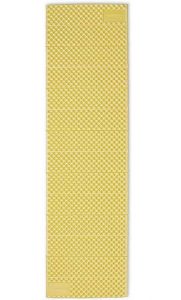
Z-Lite Foam Sleeping Pad.
Foam pads have one big benefit compared to other pads – they can’t leak.
Once upon a time, foam sleeping pads were by far the most popular pad.
Today, however, few people other than ultralight backpackers use foam sleeping pads.
The reason for foam sleeping pads declining popularity include lack of warmth and comfort (in thinner pads), as well as a low “weight to warmth” ratio when compared to quality air pads. Moreover, foam pads are, surprisingly, rather bulky—especially for the low amount of insulation provided.
While foam pads still have their place at the campground and in the backpack, air sleeping pads are, for most people, the better option.
Self-Inflating Sleeping Pads
Years ago, self-inflating sleeping pads were the workhorse. And due to their durability and lightweight, self-inflating pads are still popular – especially among campers.
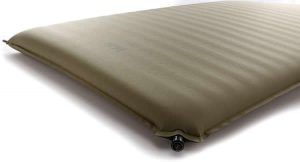
An REI Self-Inflating Pad. See more at REI.
Due to their popularity, self-inflating sleeping pads come in a myriad of insulating values, thicknesses and width.
In general, the thicker the pad the warmer and more comfortable the pad is. However, the warmer pads are also bulky and relatively heavy.
As their name suggests, self-inflating pads do self-inflate—partially. However, the pads won’t fully inflate themselves. Typically, anywhere from 5-15 breaths of air is needed to fully inflate a self-inflating sleeping pad.
Deflating a self-inflating pad is a bit of a chore. Opening the valve lets out about half the air contained in the mattress. To remove the remaining air, a person needs to slowly roll the pad, using their knees to prevent air from getting back into the pad.
Overall, for backpackers self-inflating pads make little sense anymore, since they are bulkier, heavier and not as warm as the newer ultra-light air filled sleeping pads. However, for car camping and for base camping, self-inflating pads are still a good choice.
Air Pads
The newest arrival on the sleeping pad scene is called, simply enough, an air pad. Unlike self-inflating pads, air pads aren’t self inflating.
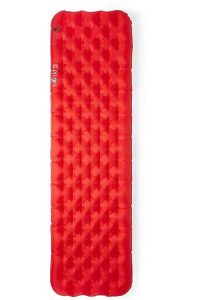
Big Agnes Air Sleeping Pad. Excellent multi-use sleeping pads. More info at REI.
In terms of “warmth to weight,” air pads provide the best value. An ultra-light four-season pad (with an R Value above 5) typically weighs less than 2 pounds and packs down incredibly small.
Because of their packability and lightweight, air pads have become the sleeping pad of choice among backpackers.
But air pads aren’t just for backpackers. For float camping and even car camping, air pads are excellent pads to use. Their thickness, warmth, ease of inflation/deflation and sheer comfort makes air pads an ideal all-around sleeping pad.
I personally use a Big Agnes Q-Core sleeping pad for my overnight float trips.
Overall, unless you have a specific reason to buy something else, most people will find air pads the best sleeping pad available for their uses. This is especially true for backpackers and campers who seek a warm, comfortable pad that still weighs little and packs down very small.
Air Sleeping Pads vs. Foam Sleeping Pads
There is no “one right choice” when deciding whether to buy a foam or air-filled sleeping pad. Each type of pad has its benefits and drawbacks. Still, there’s some general guidelines that campers might want to follow when deciding which type of pad to buy.
In terms of warmth, air-filled sleeping pads are far superior to foam pads. Most foam pads have R Value’s of less than 1.3, which is suitable for warm weather camping but of little value when the weather gets below freezing.
In terms of comfort, again, air-filled sleeping pads are superior to foam pads. Air-filled pads are typically far thicker than foam pads. That extra thickness protects the camper from objects on the ground and often makes the pad feel luxuriously soft.
With these two big advantages, campers might wonder why foam pads are even made. Well, foam pads do have their uses.
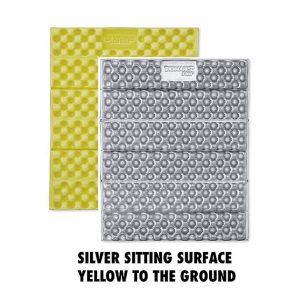
Thermarest Z-Seat always comes in handy around camp. Lightweight and packs down small. More info at Amazon.
First, foam pads have one distinct advantage over air-filled pads—they’ll never leak. While quality air filled pads are difficult to puncture and simple to repair, it’s been my experience that when air-filled pads develop a leak it always happens at the least opportune times imaginable—like 3am on a frosty or stormy night.
Second, foam pads have uses outside of sleeping. Since they are “puncture proof,” they make excellent “around camp” mats for backpackers.
Note – if you simply want a small “around camp” mat, consider buying a Thermarest Z-Seat. It weights next to nothing, packs down tiny, and makes an ideal “seat” or kneeling spot. I take along the Z-Seat on my overnight float trips and it always comes in handy. More info about the Z-Seat Trail Seat at Amazon.
Which Sleeping Pad to Choose
Which sleeping pad you choose depends entirely on the type of camping you do. Here are some suggestions to follow:
Winter Camping
Get a thick self-inflating or air pad, with an R Value of at least 5, but higher is better. A lightweight foam pad can be used beneath the air pad to increase the R Value, too. The Thermarest NeoAir Xtherm (R Value 5.7) is a superb air pad for winter camping.
For Warm Weather Backpacking
When ounces count, you there’s two choices. Choice one is an ultra-light foam pad. The problem with these pads is their low insulation value (R Value of two or less, often to .7). The second choice, and the best choice in my opinion, is an ultra-light and ultra-portable air pad. Popular air pads for backpacking and float camping are made by Big Agnes and Thermarest.
Car Camping Only
Simple. Go with the thickest, warmest, and softest self-inflating or air pad you can find. Leave the foam at home.
One Pad for Car Camping & Occasional Backpacking
If you aren’t a hard-core backpacker, but need a pad that works “ok” for backpacking, then get a rectangular shaped air pad with an R Value of at least 4. The higher R value also means the pad is softer and thicker. Also considering getting a pad that is 25 inches in width, instead of the standard 20 inches. Big Agnes, in my opinion, makes the best “dual use” air pads. But there’s nothing wrong with Thermarest pads if you don’t mind the “mummy shape.”
Recommended Multi-Use Sleeping Pad – The Big Agnes Air Pads
I own a Big Agnes Q-Core insulated sleeping pad. I bought a standard length (6 feet) but extra wide pad (25 inches) so as to be warmer and more comfortable in comparison to my older, Thermarest self-inflating pad.
The extra width and insulation added a bit more weight, but the width and insulation is worth the few extra ounces the pad weighs. I also elected to skip the ultra-light version and went with insulated version that was thicker and warmer than an ultra-light pad. My pad is five inches thick, fully inflated, and has an R Value of 5.
The reason I skipped the ultra-light version is that I wanted more warmth for cold, Montana nights. The extra warmth also greatly increases the pads versatility—I can use it in late fall without issues.
But I also wanted more comfort, frankly. A thicker pad—especially one that’s insulated—is just more comfortable than a thin, uninsulated pad. And I felt that the extra few ounces and slightly increased bulk was a small price to pay for warmer, more comfortable sleeping while camping.
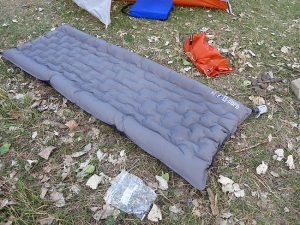
Here I’m inflating my Big Agnes Q-Core Air Sleeping Pad at a campsite along the Missouri River in Montana. This is a great multi-use pad. More info about Big Agnes pads at REI.
One advantage of the Big Agnes Q-Core pads, compared to other brands, is that they are “silent.” By that, I mean they don’t make any noise when you sit on them or move around on them. One odd thing I found about some Thermarest air pad models is that they “crinkle” when you move around on them. I found that sound annoying after a while.
A second advantage of Big Agnes pads is that they are simple to inflate. You can even use the stuff sack for bag to inflate the pad. This is a good thing, and not just because it saves your lungs. By being able to inflate the pad without breathing into it, you avoid putting water vapor inside the pad—which over time weakens the pad.
Finally, I never was wild about “mummy shaped” sleeping pads. I found too often that during the night my lower legs or feet fell off the pad, leading to cold feet. Thus, I went with a rectangular pad—and Big Agnes makes the best rectangular sleeping pads, bar none. Besides keeping my feet warm, these rectangular pads are more comfortable.
Overall, I’m very happy with my Big Agnes Q-Core sleeping pad. Sleeping on it blows away, in terms of comfort, any other sleeping pad I’ve owned. In many ways, sleeping on this pad isn’t so different than sleeping on my foldable bed that has a memory foam mattress.
While my Big Agnes Q-Core pad is a bit heavier and bulkier than a standard ultra-light air pad, I find the extra eight ounces and slight extra bulk is well-worth the price for increased comfort and warmth.
View Prices for Big Agnes Sleeping Pads at Campsaver (where I bought mine)
Where to Buy Quality Sleeping Pads
First, avoid buying sleeping pads from the big box stores. While those pads work fine for kid sleepovers, these pads are wholly unsuited for camping in Montana.
Offline, quality sleeping pads are widely available at outdoor sporting good stores that sell technical gear. In particular, REI, Cabela’s and Eastern Mountain Sports sell an extensive line of quality sleeping pads.
Online, there’s many places to buy sleeping pads.
So let me make a suggestion. Begin shopping for a sleeping pad at REI.Com. Besides having a large selection of quality sleeping pads, they provide detailed technical information about each pad. In particular, REI lists the vital insulating value (expressed as the R Value) for each pad they sell. Finally, and perhaps most importantly, you have a year to return the item. If you don’t like the comfort after sleeping on it, you can just exchange it for something else.
- View all Sleeping Pads at REI
- View all Big Agnes Sleeping Pads at REI
- View all Thermarest Sleeping Pads at REI
Other places to buy sleeping pads include Campsaver (where I bought mine during a big sale they had. Campsaver has some excellent sales), Moosejaw and Eastern Mountain Sports.

